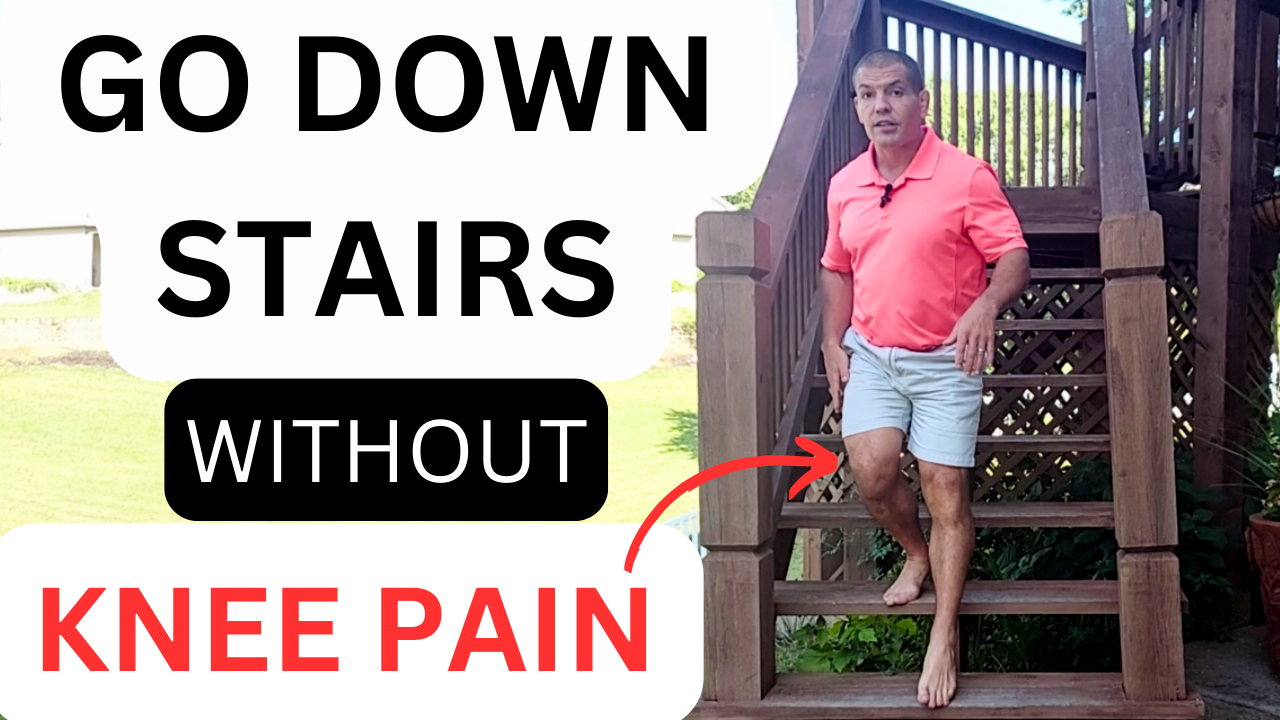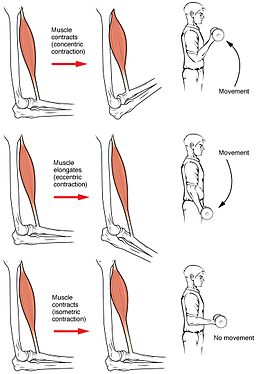Do You Get Knee Pain Going Down Stairs?
Watch the video below to learn 3 ways to stop knee pain going down stairs. 2 of them work instantly.

Why Do I Get Knee Pain Going Down Stairs But Not Up Stairs?
Many people who have knee pain have trouble going up and down stairs, but it's often going downstairs that's more painful.
That seems backward because you would think going up stairs would be more difficult, but a lot of times it is actually going down stairs that's more painful.
There are few reasons why you may get knee pain going down stairs but not up stairs:
- Eccentric muscle contraction
- Kneecap compression
- Lack of ankle dorsiflexion
Eccentric Muscle Contraction
When you contract a muscle, the muscle produces force by trying to shorten. When you're going up stairs, your thigh muscles (quadriceps) are shortening to help you climb the stairs. This is called a concentric contraction.
However, when you're going down stairs, your quadriceps muscles are lengthening while producing force (i.e. tying to shorten). This is called an eccentric contraction.
Eccentric muscle contractions cause greater muscle damage than concentric contractions due to tearing between the actin and myosin filaments involved in muscle contraction (see below).
This can create soft tissue pain going down stairs such as patellar tendonitis.
Kneecap Compression
When going down stairs, your quadriceps muscles are under tension as your knee is bending. Since your kneecap (patella) is contained inside your quadriceps tendon, this tension while bending causes compression of your kneecap on your thigh bone (femur).
This compression can cause knee pain going down stairs if you have chondromalacia patella or knee arthritis.
Lack of Ankle Dorsiflexion
If you lack dorsiflexion in your ankle, you can't get your knee over your to to go down stairs.
Therefore, your body has to find a compensation pattern. The most common compensation pattern is pronating (flattening) your foot, which drives your knee inward.
This can create cause your kneecap not to track correctly in the groove on the femur.
That in turn can cause knee pain and popping when going down stairs.
So how do you stop knee pain and popping when going down stairs?
3 Ways To Stop Knee Pain Going Down Stairs
In the rest of this post, you'll learn 3 ways to go down stairs without knee pain. The first 2 of these tips work right away. However, for the best long-term outcome, you'll also want to implement the 3rd tip.
Tip 1: Go Down Stairs One Step At A Time
The fist tip is just going downstairs one step at a time.
Most people will naturally kind of stumble on this because it's easier and less painful.
However, I have encountered people who will go down stairs where they're leading with their good leg.
They do this because they're afraid to put weight on their painful knee for fear that it might give out on them.
But in reality, it's actually the leg that's on the top stair that is doing most of the work.
Gravity is naturally pulling you down towards the center of the earth.
So you're actually fighting gravity with the leg that's on the top stair.
Even though it might be a little bit scarier to land on your painful leg, if your knee is locked out, it's probably not going to give out on you.
So if you have really bad knee pain going down stairs, then try going down stairs one step at a time leading down with the painful leg first.
However, most people want to be able to go down stairs step-over-step like "normal people" do it.
That's where tip #2 comes in.
Tip 2: Go Down Stairs Faster
There is one of my favorite tips to help you prevent knee pain going down stairs because it works immediately.
As I mentioned earlier, gravity is pulling you down towards the center of the Earth at 9.8 meters/second/second.
Just to stay stationary in one position, your body has to produce enough force to accelerate you upwards at 9.8 meters/second/second.
So you actually have to produce force just to stay still when you're going down stairs.
If you produce more force gravity, you go up.
If you produce less force than gravity, you go down.
And the less force you produce, the FASTER you go down.
So, the faster you go down, the less quadriceps force you need to use.
That means less tension on your patellar tendon and less compression on your kneecap. That means less knee pain going down stairs.
However, going down stairs fast can be scary if you have knee pain.
When you're looking down the stairs, that naturally increases your fear of falling because you can see how far you'll tumble if you fall.
Therefore people think, "My knee hurts, I have to be careful so that I don't fall."
So they go down stairs slow for fear that their knee will hurt.
But because they go down slow, their knee actually does hurt. Thus their fear becomes a self-fulfilling prophecy.
However, if they were to go down stairs faster, their knee likely wouldn't hurt.
One way to break that fear is to stand at the bottom step and hold onto the railings. Then practice going down the bottom stair quickly to overcome the fear that it will hurt.
Knee Pain Going Down Stairs From Lack of Ankle Dorsiflexion
Remember from above that another reason people have knee pain going down stairs is because they lack of dorsiflexion in their ankle.
If you lack movement at your ankle, it can cause more compression force on you kneecap. However if you bring your toes slightly over the edge of the step, it allows you to roll over the ball of your foot as you're going down stairs. This decreases how much dorsiflexion range of motion you need and allows you to go downstairs faster as described above.
So, combining the two parts of Tip 2, hang your toes over the edge of the step and then go down fast. Make sure to hold on to the handrail(s) for safety.
Tip 3: Exercises To Fix Knee Pain Going Down Stairs
This third tip takes a little bit longer, but it usually will leave you with a better long-term result. That's because you do need to improve the amount of dorsiflexion in your ankle. You also need to improve how much you're using your hip (glute) muscles.
So this third tip is an exercise progression that you can go through on the stairs to help you activate the right muscles and improve the mobility in your ankle.
Step 1: Improving ankle mobility
Start out facing up the stairs with your foot on the second step. Lean in toward the the stair so that your knee goes forward over your toe.
This is improves the mobility in your ankle joint. This is better than the stretching your calf muscles with your knee straight because one of your calf muscles, the gastrocnemius limits your ankle mobility with your knee straight.
However, when you're going down stairs, your knee is bent. So it's important to stretch with your knee bent as well in order to improve your ankle joint mobility and soleus (deep calf muscles) flexibility.
Step 2: Glute activation facing up the stairs
Step number two is to get your gluteal muscles activated.
While still facing up the stairs, put your foot on the bottom stair and the other leg on the ground.
Move your knee forward over your toe and push your heel down into the stair.
Don't push hard enough to go up the stair. This is just an isometric strengthening exercise. Hold the contraction for five to ten seconds and then relax. Repeat this for 10 repetitions.
Step 3: Glute activation facing sideways
Next you'll turn sideways and do the same type of isometric strengthening exercise.
This requires a little more ankle dorsiflexion than when you're facing up the stairs.
So again, you just activate the quadriceps and glute muscles by pushing your heel into the stair, but not hard enough to lift your bodyweight up.
Only put as much force through as you can comfortably, and on to a rail for balance.
Hold 5-10 seconds and repeat for 10 repetitions.
Step 4: Sideways step downs
While still facing sideways, do mini step downs from the bottom stair.
The deeper you go, the harder the exercise becomes, so just go as deep as you can comfortably.
As you progress, you'll want to get your non-weightbearing leg in front the one that's one the stair.
Ultimately, to be able to go down stairs without knee pain, you need to be able to get that foot out in front of you.
Do 10 or 20 repetitions only as deep as you can comfortably.
Step 5: Going down stairs without knee pain
Once you can do the full depth of the step down with your other foot in front of you, you'll have the range of motion that you need to go down stairs.
Stand on the bottom step and face down the stairs. If you've gone through the exercise progression successfully, you should be able to go down stairs without knee pain.
This third tip may not work immediately if you have more severe knee pain goiing down stairs.
It may take days, weeks, or even months depending on where you're starting to increase the mobility in your ankle as well as increase the strength in your glutes.
But in the meantime, either go down stairs one leg at a time or hang your toes over the edge of the step and go down faster.
Those tips will help you to almost instantly relieve your knee pain going down stairs while you're working on a longer-term solution.
Getting Help For Knee Pain Going Down Stairs
If you try these tips and still have some knee pain, it may be time to a physical therapist. Make sure to do your research though as not all physical therapists are the same. You want someone who thoroughly understand the biomechanics of the hip, knee, ankle, and foot AND how they all interact with one another.
If you're in the St. Louis area and you need some more help for knee pain, we'd be happy to help you here at More for Life.
Just tap the button below to request an appointment with one of our specialist physical therapists.














